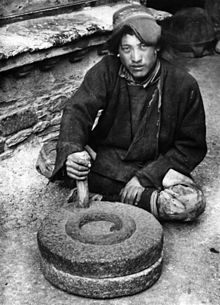Hand rotary mill
A hand rotary mill (also known as rotary hand mill , often just called hand mill ; Low German Quern , spelling alternatively Kw / Qu | e / i / a / ae / ä | rn ) is a simple grinding mill consisting of two millstones , the upper one of which is from Hand is rotated by human muscle power. This type of mill was and is mainly used for grinding grain in small quantities.
history
The hand rotary mill is a further development of the simplest grinding stones ( grinding stones) and mortars , as they were already used during the Stone Age .
The time of the appearance of the first manual rotary mill is unknown. The hand rotary mill is said to be based on an invention in the Ibero-Celtic region. In a Celtic hilltop settlement from the 7th or 6th century BC In addition to spelled , emmer and barley , millstone fragments from basalt lava were also found . It is used in Greece for the time around 500 BC. Known. In Germany, Stefanie Wefers compiled the Latène period hand turning mills from Hessen and is of the opinion that they were already in use there before the late Latène period (190 BC until the turn of the century). In Dunadd Hill Fort in Scotland about 20 millstones were found belonging to the 8th century.
Structure and functionality
The devices consisted of two flat stones and a central centering ( axis ) or conical self-centering grinding surface. As a rule, they were stones with a diameter of 35 to 45 cm. The upper runner stone was placed on a wrought-iron peg that protruded from the bottom stone. The runner turned on the iron pivot without the grinding surfaces touching. The handle was either an angled handle in the side or from above in the runner stone. Later, the rotor was fitted with a vibrating rod, the upper part of which was laterally immovable, which made the work of turning much easier. Most hand turning mills turn clockwise, as this direction is preferred by right-handers.
literature
- R. Bockius, G. Bosinski, F. Hört u. a .: quarry and mine. Monuments of Roman technical history between the Eifel and the Rhine . Catalog handbook for the exhibitions in the museums of Mayen and Andernach. In: Vulkanpark research . 2nd volume. Römisch-Germanisches Zentralmuseum, Mainz 2000, ISBN 3-88467-048-4 .
- Stefanie Wefers: Latène period hand turning mills in North Main Hesse . In: A. Belmont, F. Mangartz (eds.): Mill stone quarries. Research, protection and valorisation of a cultural heritage of European industry (antiquity up to the 21st century) International Colloquium Grenoble, 22nd to 25th September 2005. Römisch-Germanisches Zentralmuseum, Mainz 2006, p. 15-24 .

